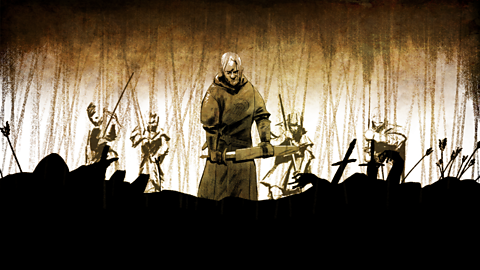NARRATOR:
England in the 11th century was one of the best governed and wealthiest states in all Europe. There were plenty of silver coins in circulation and food was generally plentiful. The country was ruled by Anglo-Saxons, having fought off Vikings for hundreds of years, and local sheriffs meant people usually felt safe and secure. But on 5th January, 1066, King Edward the Confessor put England in terrible danger. He died without leaving a son and heir. This was a disaster. It left the country vulnerable to attack from claimants battling for the prized English Crown. The new king would need to be chosen by the Witan, the King's councillors, an assembly of powerful nobles. But there were four people who each believed he was the most entitled to the throne. So who would the Witan choose?
First up was Edgar the Aethling. He was the Anglo-Saxon prince and great-nephew of the late King. In 1057, Edward the Confessor had named Edgar's father heir to the throne. But he died under suspicious circumstances before he could be crowned. Aged just 15, his son Edgar lacked both the experience and necessary support to become king.
Next up was the King of Norway, Harald Hardrada, or hard ruler - a formidable Viking warrior. His claim was also based on an earlier promise made to his father. Between 1016 and 1042, England had been ruled by Danish Vikings. The last of them was Harthacnut. Harthacnut had named Magnus, King of Norway, as his successor. But when Harthacnut died, the English crown went to Harthacnut's Anglo-Saxon half-brother instead - none other than Edward the Confessor. Magnus died soon afterwards, so when the English crown came up for grabs again in 1066, Harald Hardrada leapt at the chance to claim back what he believed his father had been denied.
Then there was Harold Godwinson, an Anglo-Saxon, who believed he should be Edward's successor. Harold was the Earl of Wessex, the richest man in the kingdom and had good alliances with all the major nobles of England. He had been the late King's advisor, governing the country on Edward the Confessor's behalf, whilst the King was busy with his religious pursuits. King Edward had even married Harold's sister, Edith. Harold also claimed the late King had promised him the throne on his deathbed. This assertion was backed up by the Anglo-Saxon Chronicles. But this was hardly surprising as Harold was an Anglo-Saxon.
And finally there was William, Duke of Normandy, a distant cousin of the late King. Edward the Confessor had lived in Normandy for 25 years prior to his coronation, so he actually knew William better than his English nobles. England had been ruled by Anglo-Saxons or Vikings for the last 200 years. William was neither. William claimed that King Edward had promised him the throne, and this, of course, was the version reported by the Norman chroniclers. What's more, William had many supporters, including the Pope in Rome, which meant, in effect, he also had the backing of God. To top it off, William declared that in 1064, Harold Godwinson had sworn loyalty to him on sacred relics, as illustrated on the greatest of all surviving Norman records, the Bayeux Tapestry. If this was true, Harold was probably forced to do so - and after all, the Bayeux Tapestry was commissioned by William's brother.
So, here are the four main claimants - but only one of them could be king. The Witan chose English Harold Godwinson, and fearing an invasion, promptly crowned him king at Westminster Abbey… which was coincidentally the same day that King Edward the Confessor had his funeral. But just because Harold had now become king, didn't mean he would stay king. On 24th April, Halley's comet appeared in the sky. It was believed to be a sign from God, indicating a great change was about to happen. Some even called it the terror of kings. Whatever the interpretation, history tells us it was the start of a war over the Crown which would transform England forever.
Video summary
In 1066, it seems that four people - Edgar Aethling, Harald Hardrada, Harold Godwinson and William of Normandy - had all been promised the throne at one stage during his reign by Edward the Confessor, but who exactly had the strongest claim?
And which of them would the Witan, the Anglo-Saxon council, select?
It was very dangerous for a country when the King died without a clear heir to the throne, so swift action was needed.
Harold Godwinson was chosen as king on the very day that Edward was buried.
But how would the other three claimants to the throne react?
Please note: during the film it is suggested that Harald Hadrada was King Magnus I's son. It is now thought that this was not the case and Harald Hadrada was in fact King Magnus I's uncle.
Teacher Notes
Key Stage 3:
This could be used as part of an activity for students to weigh up the evidence. Whilst watching this short film students could make bullet point notes summarising the claim of each person wanting to be king of England. They could then discuss their bullet point lists with others in the group until everyone is happy with the list. Then they could rank the four claimants, according to the strength of their claim and complete the following 'I believe … had the best claim to be King of England in January 1066 because …'
Key Stage 4:
Students could construct a timeline using the evidence in the film, from 1000 to 1066. On their timeline students could mark the event(s) that each of the claimants argues gave them the right to the throne of England. Then using the timeline they could construct a narrative explaining why there was a dispute over who should be the next king of England following Edward's death in early 1066.
This short film will be relevant for teaching history in secondary schools in the UK. This topic appears in OCR, Edexcel, AQA, WJEC KS4/GCSE in England and Wales, CCEA GCSE in Northern Ireland and SQA National 4/5 in Scotland.
1066: The Battle of Fulford (2/6) video
In the first major battle of 1066, the Viking king of Norway, and Harold Godwinson's own brother Tostig, invade the north of England.
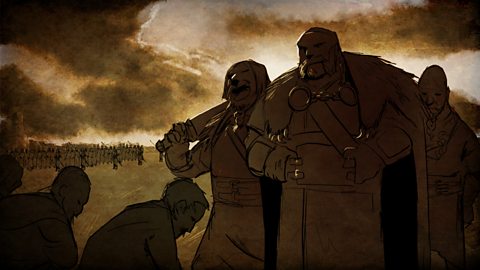
1066: The Battle of Stamford Bridge (3/6) video
The Battle of Stamford Bridge was the second major battle in the fight for the throne in 1066 and two of the four contenders were killed.
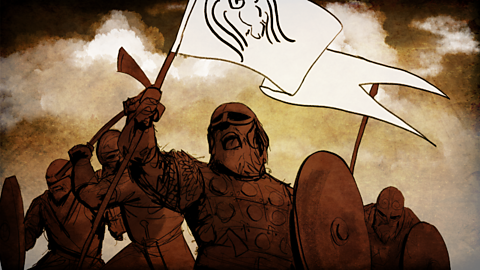
1066: The Battle of Hastings (4/6) video
William of Normandy arrives in Sussex for the decisive battle of the Norman Conquest.
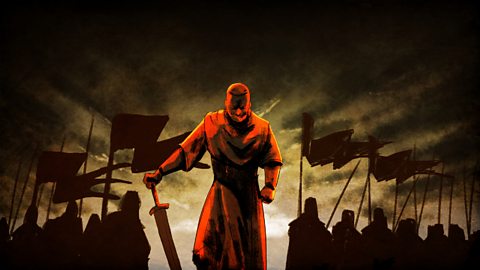
1066: King William and Domesday Book (5/6) video
How William the Conqueror secured control over England.
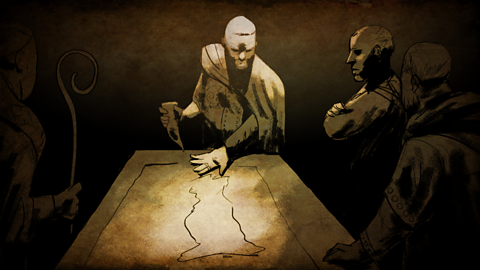
1066: Revolt and resistance (6/6) video
How did the Anglo-Saxons resist Norman rule after 1066?
